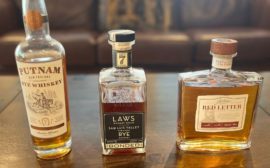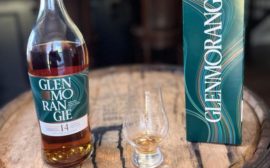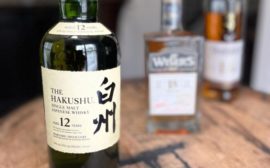Blending has always been on my radar, especially after attending a Tour at Glenfiddich Distillery in 2015 named Glenfiddich Solera Cask Deconstructed. In that experience, guests taste all components of Glenfiddich 15yo and blend these to create their personalized Solera single malt.
The Blending Kit
A week before my last visit to the Hiram Walker Distillery in Windsor, Ontario, I purchased a blending kit online on J.P. Wiser’s website as a fun way to learn about flavors and make my own blend.
The kit includes five blends: rye, spice, smoke, wine, and 5-year-old. Before blending, I sampled all five components and plotted their flavors in a spider graph. After some analysis, I created five final blends:
Blend #1. The “All Equal” Blend
The goal of the first blend was to give each component a chance to showcase its attributes, none dominating the overall flavor.
- Rye: 10ML/20%
- Spice: 10ML/20%
- 5-Yo: 10ML/20%
- Smoke: 10ML/20%
- Wine: 10ML/20%
Observations: The first impression about the “All Equal” blend was it lacked personality and power. Perhaps adding equal parts was not the way to go, but one can never find out until you blend.
To my surprise, the oak-driven by the 5-Yo expression resulted in a bitter sensation in the finish I did not enjoy. I have tasted many older whiskies (18+) and did not feel the bitterness, so it must have been the type of cask and the age.
Score: 2/5⭐
Blend #2. The Canadian Experiment
The goal of the blend was to increase the proportion of core components typically associated with Canadian Whisky.
- Rye: 15ML/30%
- Spice: 15ML/30%
- 5-Yo: 10ML/20%
- Smoke: 5ML/10%
- Wine: 5ML/10%
Observations: The texture of the blend was creamy with baking spices such as cinnamon, vanilla, clove, pepper, and ginger. The finish was short but not very oaky and bitter.
The Canadian Experiment was an approachable and fun blend that served as a reference for subsequent experiences on the flight.
Score: 3.75/5⭐
Blend #3. The Smoky Blend
In this blend, the question was whether the high proportion of smoke would play well with other flavor profiles.
- Rye: 10ML/20%
- Spice: 5ML/10%
- 5-Yo: 10ML/20%
- Smoke: 20ML/40%
- Wine: 5ML/10%
Observations: The smoke played well with the baking spices and enhanced the blend by providing more character and elegance. I was gladly surprised by the fact that the smoke did not dominate the experience even though it had the highest proportion in the blend.
I must admit that I have developed a high tolerance for smoke due to exposure to Islay single malts, so the smoke did not even come close to brands like Ledaig, Bruichladdich, or Caol Ila. Nonetheless, the blend worked, and it provided enough depth to keep me thinking if this was the best blend of the flight.
Score: 4/5⭐
Blend #4. The Short Blend
What if the blend had only rye, spice, and 5Yo?
- Rye: 20ML/40%
- Spice: 15ML/30%
- 5-Yo: 15ML/30%
- Smoke: 0ML/0%
- Wine: 0ML/0%
Observation: The blend started with Canadian flavors (baking spices). However, the 5-Yo came roaring with the oaky-bitter note in the mid-palate and the finish did not do it for me.
I do not know the ages of the components, but the 5-Yo influenced the blend significantly at 30%. This blend ranks at the bottom of the pack for me and confirms why some bourbon brands bottled at cask strength and barrel-driven do not work for me.
Score: 3.25/5⭐
Blend #5. The Spicy Blend
Will the spicy flavor dominate all other flavors?
- Rye: 15ML/30%
- Spice: 25ML/50%
- 5-Yo: 5ML/10%
- Smoke: 5ML/10%
- Wine: 0ML/0%
Observations: This blend resulted in the best proportion of oak to all other blending components by complementing the experience and downplaying the characteristic bitterness commonly associated with the 5-Yo. Although present, the oak felt restrained and in the right proportion providing personality to the overall flavor of the blend. The spicy flavor drove the experience but did not overshadow all other flavors, especially the rye and the 5-Yo.
Score: 3.5/5⭐
Learnings
- The blends that worked for me were the ones that highlighted my favorite core flavors of rye and spice and supplemented these with secondary flavors that rounded the overall experience. For example, a smoky profile combined with the rye and spice profiles resulted in an intense and robust blend that I considered the best of both worlds (Canadian and Scotch).
- Traditional flavors in Canadian whiskies, such as vanilla, ginger, and clove, stand at the top of my list. The oak profile was dialed-down to no more than 20% of the blend to avoid bitterness. After reviewing multiple barrel forward bourbons in my blog bottled at cask strength, it is clear that too much oak will ruin things for me.
- The wine profile is something I enjoy when in moderation and should round the experience while letting the other core flavors lead it.
- Ranking my flavor profiles from favorite to least favorite are spice, rye, smoke, oak, and wine.
- Blending within one category is the first step, but across categories (i.e., Japanese, Irish, etc.) could be even more educational.
- Not looking at the recipes provided in the kit was a good decision, not because these were inaccurate, but because they would have influenced my criteria.
- Drawing a spider graph for each component before blending was a good decision because it allowed me to identify these more easily in the final product.
I hope you found this exercise helpful when creating your blends at home.
Check more blended whiskies here. Don’t forget to check my reels on Instagram.





